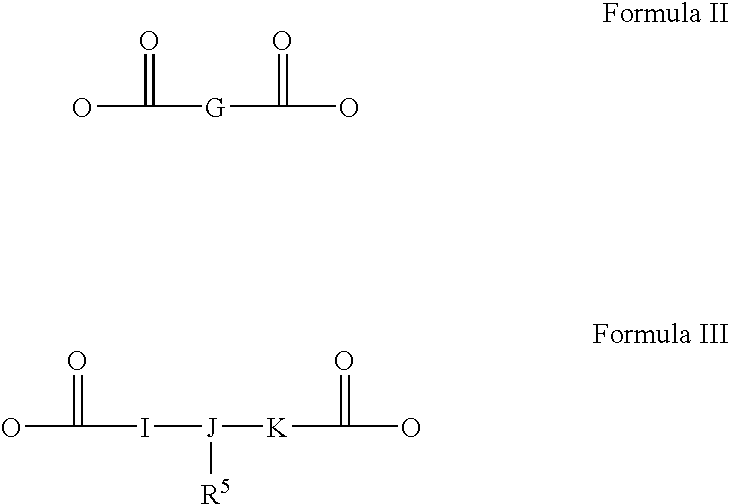Personal care product containing diester quat
a technology of diester quat and personal care products, applied in the field ofquaternary compounds, can solve the problems of environmental pollution, quat breakage, and certain quats, and achieve the effects of improving stability in a higher ph, improving substantivity, and improving environmental properties
- Summary
- Abstract
- Description
- Claims
- Application Information
AI Technical Summary
Benefits of technology
Problems solved by technology
Method used
Image
Examples
example # 1
EXAMPLE #1
Preparation of PPG-4 PEG-6 N-Methyldiethanolamine
[0142] To a clean, dry stirred tank pressure vessel with Nitrogen inlet was charged 482.08 g (4.05 moles) of N-Methyldiethanolamine, a catalytic amount (5.54 g) of 45% KOH and 0.92 g of NaBH4 as a color preservative. The vessel was then purged with Nitrogen and heated to 110° C. Vacuum was applied for one hour to remove trace amounts of water, after which the temperature was raised to 130° C. Propylene Oxide in the amount of 939.88 g (16.18 moles) was added at such a rate so the pressure remained below 50 psig. After all Propylene Oxide was added, the batch was left to react to constant pressure for an additional 4 hours after which the temperature was raised to 160° C. Ethylene Oxide in the amount of 1069.02 g (24.26 moles) was added at such a rate so that the pressure stayed below 50 psig. After all Ethylene Oxide was added the batch was left to react for an additional hour after which the temperature was lowered to 110° ...
example # 2
EXAMPLE #2
Preparation of PPG-4 PEG-6 N-Methyldiethanolamine Di-Lanolate
[0143] To a clean dry stirred tank pressure vessel with Nitrogen inlet and fitted with a distillation column was charged 1204.84 g (1.94 moles) of the Alkoxylate from example 1, 1290.28 g (3.68 moles) of Lanolic Acid (from Croda, Inc.) and a catalytic amount (6.25 g) of 50% Hypophosphorous Acid. The batch was heated to 220° C. under Nitrogen sparge and held for one hour after which 100 mm Hg of vacuum was applied. During vacuum, the batch was monitored by measuring the Acid Value. The reaction was considered complete when the Acid Value reached 3.1 mg KOH. The finished product was a viscous amber liquid.
example # 3
EXAMPLE #3
Preparation of PPG-4 PEG-6 N-Methyldiethanolamine Dibehenate
[0144] To a clean dry stirred tank pressure vessel with Nitrogen inlet and fitted with a distillation column is charged 268.16 g (0.44 moles) of the Alkoxylate from example 1, 281.82 g (0.83 moles) of Behenic Acid and a catalytic amount (1.38 g) of 50% Hypophosphorous Acid. The batch is heated to 220° C. under Nitrogen sparge and held for one hour after which 100 mm Hg of vacuum is applied. During vacuum, the batch is monitored by measuring the Acid Value. The reaction is considered complete when the Acid Value is preferably less than 5 mg KOH.
PUM
| Property | Measurement | Unit |
|---|---|---|
| pressure | aaaaa | aaaaa |
| temperature | aaaaa | aaaaa |
| temperature | aaaaa | aaaaa |
Abstract
Description
Claims
Application Information
 Login to View More
Login to View More - R&D
- Intellectual Property
- Life Sciences
- Materials
- Tech Scout
- Unparalleled Data Quality
- Higher Quality Content
- 60% Fewer Hallucinations
Browse by: Latest US Patents, China's latest patents, Technical Efficacy Thesaurus, Application Domain, Technology Topic, Popular Technical Reports.
© 2025 PatSnap. All rights reserved.Legal|Privacy policy|Modern Slavery Act Transparency Statement|Sitemap|About US| Contact US: help@patsnap.com



